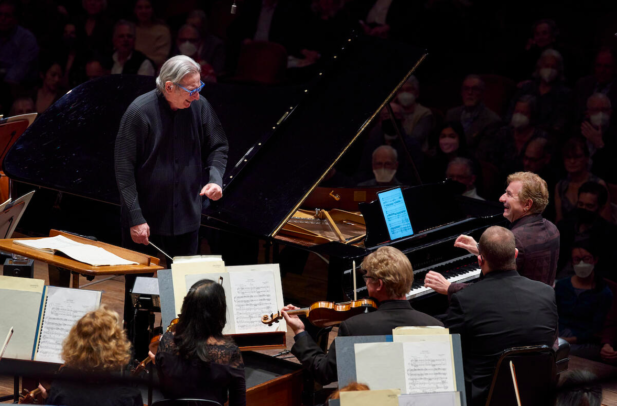 United States Debussy, Messiaen, Villa-Lobos: Jean-Yves Thibaudet (piano), Cynthia Miller (ondes Martenot), San Francisco Symphony Chorus (guest director: Grant Gershon), San Francisco Symphony / Michael Tilson Thomas (conductor). Davies Symphony Hall, San Francisco, 26.1.2023. (HS)
United States Debussy, Messiaen, Villa-Lobos: Jean-Yves Thibaudet (piano), Cynthia Miller (ondes Martenot), San Francisco Symphony Chorus (guest director: Grant Gershon), San Francisco Symphony / Michael Tilson Thomas (conductor). Davies Symphony Hall, San Francisco, 26.1.2023. (HS)

Debussy – Prélude à l’aprés-midi d’un faune; Fantaisie for Piano and Orchestra
Messiaen – Trois petites liturgies de la Présence Divine
Villa-Lobos – Chôros No.10, ‘Rasga o coroção’
Something extra infuses the San Francisco Symphony when Michael Tilson Thomas returns to conduct the band. The musicians’ signature accuracy and flexibility are there, but so is a level of communication about tone that makes the music breathe, which was evident throughout a program on Thursday at Davies Symphony Hall. All four pieces had been featured and conducted by Tilson Thomas during his tenure as the orchestra’s music director. Three of them were heard only once before in recent memory.
The conductor, who had a brain tumor removed in August 2021, may have looked a bit haggard but he still showed full command of and communication with the orchestra. He drew forth an evening of dedicated playing in these rarely heard works from composers he has always favored – Claude Debussy, Olivier Messiaen and Heitor Villa-Lobos. As always, the performances reflected Tilson Thomas’s ability to get particularly colorful textures and lively rhythms.
The lead-in was the oh-so-familiar Prélude à l’aprés-midi d’un faune. Debussy’s delicate tone poem took on a subtle sheen, the rhythms pulsing gently, the melodic lines undulating, the tone a serene auburn. Under other conductors, Debussy’s music can sometimes overdo the gauziness or get a bit too clipped, but Tilson Thomas always finds the balance between precision and soft textures.
Guest flutist Blair Francis Paponiu (the principal’s chair is unfilled for now) delivered the opening solo with winning grace. The piece found an unhurried pace that somehow never lagged either. What struck me most was the fluidity and unaffectedness of the music’s flow and the gentle fadeout at the end.
The Messiaen ‘Liturgies’ which followed belied their ‘petite’-ness with the clangor of the composer’s fascination with transforming bird song into raucous piano music and the sound of the ondes Martenot, an instrument he often used for distinctive swooping effects. An early electronic keyboard instrument, the ondes can sing like an organ and swoop like a theremin to bring extra whoops to ecstatic phrases, especially when it combines with the joyful sound of a women’s chorus, as it did here. The redoubtable French pianist Jean-Yves Thibaudet executed the piano’s exuberance with flair and precision.
Tilson Thomas corralled this into a coherent 40 minutes, managing to cram in all the notes and then letting it explode deliriously.
The other Debussy piece, Fantaisie for Piano and Orchestra, is something of a rarity. Though written in 1890, it was never performed before Debussy’s death in 1918. A score published in 1919 did not contain the composer’s significant revisions to rebalance the piano with the orchestral sound. The final version at last appeared in 1968.
Although the sequence of two lively movements around a slow meditative Lento reflects the form of a traditional classical concerto, what makes it different is the not-quite-formal structure of the music. The piano never stops in this piece, and it can seem as free as improvisation. Thibaudet, who excels at free-form music that can border on jazz, is a master of this sort of thing.
Debussy’s whole-tone scales and cluster chords are about as daring as the musical language gets, but the sense of freedom and the lack of familiarity with the piece for both musicians and audience gave it an extra frisson as we all discovered its assets together. That reflects another aspect of Tilson Thomas’ tenure – his persistent ability to find unfamiliar music with depth and value that audiences could savor on the first hearing.
To top things off came the rousing rhythms and ear-thwanging harmonies of Villa-Lobos’s Chôros No.10, the most famous of a series written between 1920 and 1929 that precedes the more familiar Bachianas Brasileiras. This one feels more raw, and it works best when delivered with a sense of abandon. It benefited from the direction of Grant Gershon, who got the full chorus rockin’ and rollin’ with the driving rhythms to underline what Tilson Thomas was getting from the orchestra.
Over its 12 minutes, the piece seemed to summarize the combination of exoticism and classical rigor that all these pieces shared, and it brought the proceedings to a thrilling peak.
Harvey Steiman
